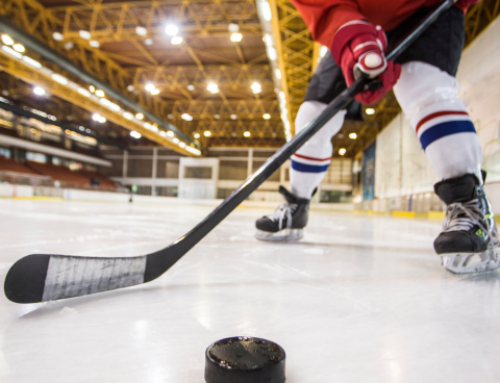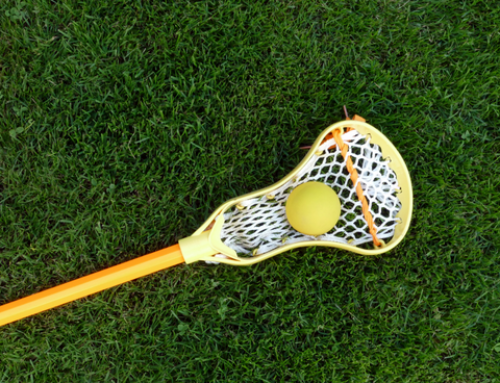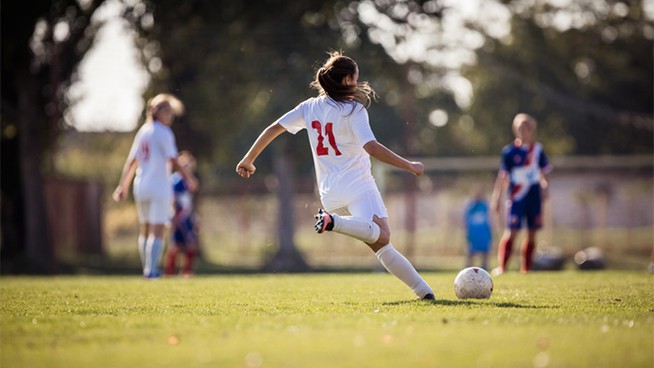5 Tips to Master the Slide Board Speed Skater Exercise (With 5 Advanced Variations)
The Slide Board Speed Skater is a phenomenal low-impact lateral exercise that can improve change of direction speed. It’s popular with hockey players because of the stride, but it can improve almost any athlete’s performance.
If you’re unfamiliar with a slide board, it’s a long rectangular shaped board with a slick white covering constructed from polyurethane with two adjustable wooden blocks that sit at each end. These days, there are several uses for slide boards, but in this article I’ll be thoroughly covering the Lateral Speed Skater, which is shown above.
Here are the tips you need to properly perform this exercise.
Proper Slide Board Posture
Much like many athletic movement-oriented drills, the slide board exercise is no different as far as initial alignment and posture are concerned. From the front, there should be vertical lines drawn from the front of the foot all the way up through the front of the shoulder. From the side, the joints should be stacked on top of each other (shoulders on top of knees, knees on top of toes), with the back locked straight and the neck in a packed position.
Hip Height
The exact angle of where the hips should stay is up for debate, but a knee and hip angle of approximately 45 degrees (quarter squat) seems to work well for lower-body strength and power output. Just make sure that your hips stay on a level plane and don’t rise up and down during the work interval.
Arm and Leg Drive
Yes, you are going to need to mimic a speed skater with this one. The inside arm relative to where you are headed needs to extend and drive back rapidly, while the opposite side arm comes across the body. Make sure you don’t rotate your torso and the rest of your body, as the slide board exercise is intended mostly to hone skill in the lateral direction. The outside leg in contact with the wooden block should drive “down and out” at the same time arm action is occurring. This arm and leg pattern ignites an essential and explosive reflex, giving you more strength and power. It demands that your lateral hip get stronger, which is key to long-term structural health and performance.
Foot Position
When it comes to foot position, there are a few things you will need to be more efficient and successful. First, ensure that there is adequate foot separation, especially at block contact. This feature helps provide a better base of support and quickness in the drill. Another common error with the feet involves excessive turning them out (external rotation), which can hamper strength and power. True, turning the feet out can be productive in training settings such as squatting and band-walking exercises and their variations; but when it comes to pure athletic movement positioning, you’ll be much better served by keeping your feet pointing straight.
Frequency
The simplest and most effective cue for the slide board is adopting an explosive approach, attempting to deliver as many foot contacts as you can and driving your body mass as fast as humanly possible until the set is finished. Your body adapts precisely to how you elect to train it, so if your main goal is power, then maximal effort better be there or performance gains and progress will be limited. The slide board is no exception. A quick and easy tactic you can use here is the “Count Method.” Compete and measure how many times you hit the block during a work interval
For more information on how these exercises will increase your speed, check out the Speed Encyclopedia
And after you have mastered all of the techniques and guidelines above, you can begin to incorporate variations into your training program.
5 Advanced Slide Board Alternatives
Pallof Press
[youtube video=”je-sjPiuriY” /]The Pallof Press is typically done using a cable system. The longer arm lever that you create with a weighted object placed in the hands signals the core to contract harder, increasing trunk stiffness, which is essential to literally every exercise you can think of. Athletes are often lacking in this department when assessing their core function. Moreover, by holding the arms in a static position, you place a greater workload on weak areas of the lower body.
Concentric Focused
[youtube video=”8VdVUHbdRlw” /]By incorporating distinct pauses each time you arrive to a block, you can shift the focus of muscle contraction to the concentric or shortening phase, where most rapid acceleration occurs. This helps with tension, deceleration, first-step explosiveness and conditioning the nervous system and target muscles to self-generate force rather than relying on momentum and other built-in supportive responses from muscles and adjacent tendons to move faster. By doing so, you will have both channels of strength displayed at your disposal during movement so that you can maximize your power and performance in sport.
The Haltere Method
[youtube video=”M7QbbKodzNg” /]Haltere training was recently supported in some credible research[1]. It involves a slight overload in the hands, much like the Pallof Press. The difference is that the arms are free to move, and the full range of motion they create produces a cascade of performance benefits in both the arms and legs, ultimately leading to more perceived finesse and quickness in motion.
Weight Vest
[youtube video=”gDZDTmsrfD0″ /]Many athletes struggle to create and sustain a stationary bent-over position with the Lateral Speed Skater, mainly because they suffer from a weak back from top to bottom. The beauty of the vest is that it can accommodate your current level of back strength and make it even a little stronger by adding a small quantity of additional weight (not to mention the constant resistance placed on the lower body).
Resistance Bands
[youtube video=”n6qqC2VxaaI” /]The option of resistance bands to elevate intensity may be superior to the vest. Bands increase horizontal force production, which has been proven critical for developing start and acceleration capabilities. What’s more, when applied appropriately around the waist, the bands cause an automatic switching effect between improving acceleration and deceleration. When you consider the high prevalence of ankle injuries, this becomes even more invaluable, since it strengthens foot, ankle and hip, which may help decrease the likelihood of suffering an excessive ankle roll at another time.
For more information on how these exercises can increase your speed, check out the Speed Encyclopedia
READ MORE:
- The 7 Best Slide Board Exercises
- Dwyane Wade Slide Board Dynamic Glute/Hip Stretch
- Why Hockey Players Should Train on a Slide Board
- James Harden Slide Board Circuit
Reference
[1] Rosas, F., “Jump Training in Youth Soccer Players.” Int J Sports Med, 37: 1060-1065, 2016. [cf]skyword_tracking_tag[/cf]RECOMMENDED FOR YOU
MOST POPULAR
5 Tips to Master the Slide Board Speed Skater Exercise (With 5 Advanced Variations)
The Slide Board Speed Skater is a phenomenal low-impact lateral exercise that can improve change of direction speed. It’s popular with hockey players because of the stride, but it can improve almost any athlete’s performance.
If you’re unfamiliar with a slide board, it’s a long rectangular shaped board with a slick white covering constructed from polyurethane with two adjustable wooden blocks that sit at each end. These days, there are several uses for slide boards, but in this article I’ll be thoroughly covering the Lateral Speed Skater, which is shown above.
Here are the tips you need to properly perform this exercise.
Proper Slide Board Posture
Much like many athletic movement-oriented drills, the slide board exercise is no different as far as initial alignment and posture are concerned. From the front, there should be vertical lines drawn from the front of the foot all the way up through the front of the shoulder. From the side, the joints should be stacked on top of each other (shoulders on top of knees, knees on top of toes), with the back locked straight and the neck in a packed position.
Hip Height
The exact angle of where the hips should stay is up for debate, but a knee and hip angle of approximately 45 degrees (quarter squat) seems to work well for lower-body strength and power output. Just make sure that your hips stay on a level plane and don’t rise up and down during the work interval.
Arm and Leg Drive
Yes, you are going to need to mimic a speed skater with this one. The inside arm relative to where you are headed needs to extend and drive back rapidly, while the opposite side arm comes across the body. Make sure you don’t rotate your torso and the rest of your body, as the slide board exercise is intended mostly to hone skill in the lateral direction. The outside leg in contact with the wooden block should drive “down and out” at the same time arm action is occurring. This arm and leg pattern ignites an essential and explosive reflex, giving you more strength and power. It demands that your lateral hip get stronger, which is key to long-term structural health and performance.
Foot Position
When it comes to foot position, there are a few things you will need to be more efficient and successful. First, ensure that there is adequate foot separation, especially at block contact. This feature helps provide a better base of support and quickness in the drill. Another common error with the feet involves excessive turning them out (external rotation), which can hamper strength and power. True, turning the feet out can be productive in training settings such as squatting and band-walking exercises and their variations; but when it comes to pure athletic movement positioning, you’ll be much better served by keeping your feet pointing straight.
Frequency
The simplest and most effective cue for the slide board is adopting an explosive approach, attempting to deliver as many foot contacts as you can and driving your body mass as fast as humanly possible until the set is finished. Your body adapts precisely to how you elect to train it, so if your main goal is power, then maximal effort better be there or performance gains and progress will be limited. The slide board is no exception. A quick and easy tactic you can use here is the “Count Method.” Compete and measure how many times you hit the block during a work interval
For more information on how these exercises will increase your speed, check out the Speed Encyclopedia
And after you have mastered all of the techniques and guidelines above, you can begin to incorporate variations into your training program.
5 Advanced Slide Board Alternatives
Pallof Press
[youtube video=”je-sjPiuriY” /]The Pallof Press is typically done using a cable system. The longer arm lever that you create with a weighted object placed in the hands signals the core to contract harder, increasing trunk stiffness, which is essential to literally every exercise you can think of. Athletes are often lacking in this department when assessing their core function. Moreover, by holding the arms in a static position, you place a greater workload on weak areas of the lower body.
Concentric Focused
[youtube video=”8VdVUHbdRlw” /]By incorporating distinct pauses each time you arrive to a block, you can shift the focus of muscle contraction to the concentric or shortening phase, where most rapid acceleration occurs. This helps with tension, deceleration, first-step explosiveness and conditioning the nervous system and target muscles to self-generate force rather than relying on momentum and other built-in supportive responses from muscles and adjacent tendons to move faster. By doing so, you will have both channels of strength displayed at your disposal during movement so that you can maximize your power and performance in sport.
The Haltere Method
[youtube video=”M7QbbKodzNg” /]Haltere training was recently supported in some credible research[1]. It involves a slight overload in the hands, much like the Pallof Press. The difference is that the arms are free to move, and the full range of motion they create produces a cascade of performance benefits in both the arms and legs, ultimately leading to more perceived finesse and quickness in motion.
Weight Vest
[youtube video=”gDZDTmsrfD0″ /]Many athletes struggle to create and sustain a stationary bent-over position with the Lateral Speed Skater, mainly because they suffer from a weak back from top to bottom. The beauty of the vest is that it can accommodate your current level of back strength and make it even a little stronger by adding a small quantity of additional weight (not to mention the constant resistance placed on the lower body).
Resistance Bands
[youtube video=”n6qqC2VxaaI” /]The option of resistance bands to elevate intensity may be superior to the vest. Bands increase horizontal force production, which has been proven critical for developing start and acceleration capabilities. What’s more, when applied appropriately around the waist, the bands cause an automatic switching effect between improving acceleration and deceleration. When you consider the high prevalence of ankle injuries, this becomes even more invaluable, since it strengthens foot, ankle and hip, which may help decrease the likelihood of suffering an excessive ankle roll at another time.
For more information on how these exercises can increase your speed, check out the Speed Encyclopedia
READ MORE:
- The 7 Best Slide Board Exercises
- Dwyane Wade Slide Board Dynamic Glute/Hip Stretch
- Why Hockey Players Should Train on a Slide Board
- James Harden Slide Board Circuit
Reference
[1] Rosas, F., “Jump Training in Youth Soccer Players.” Int J Sports Med, 37: 1060-1065, 2016. [cf]skyword_tracking_tag[/cf]









